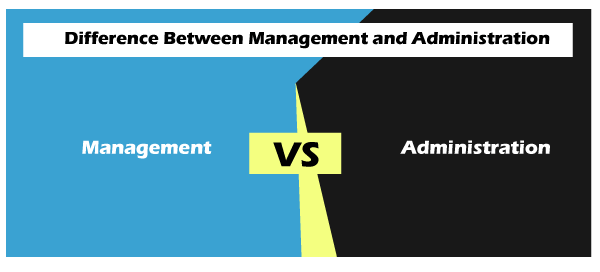Difference between Management and AdministrationWe have studied many business-related terms that are applicable in every office or organization. Many business terms like management, team-building, administration, etc., are used almost everywhere. So, what do management and administration mean? Well, in layman's language, management means the way a manager manages the company or an organization by distributing work to employees. On the other hand, administration means that how the business or an organization is running. These are the common definitions of management and administration. Let us look at the business-related meaning of these terms. ManagementManagement is defined as the process of administering an organization or a business. The manager can control or guide the employees to reach the tasks/ goals assigned to them. A manager is responsible for handling, guiding, and supervising the employees so that the organization runs smoothly and efficiently. Management is important for every company and organization as each department has to be managed differently. There are three significant kinds of management styles, i.e., autocratic management style, democratic management style, and laissez-faire management style. One of the important examples of management is how a CEO of the company manages all the departments differently. 
AdministrationThe administration is the process of managing the responsibilities and duties provided to the employees. An administrator is responsible for the smooth and efficient running of an organization. He/ she also make sure that the employees work efficiently so that the company yields profit. Administrators are the intermediaries between employees and senior management. They help in motivating and inspiring the employees so that they can reach their goals. Some of the administrative skills include communication, multi-tasking, responsibility, time management, etc. Well, there are several differences between management and administration. So, let us discuss them.
So, these are some of the major differences between management and administration. It is essential to note that management and administration are significant parts of an organization. Now, let us look at some of the types of management and administration. Types of ManagementManagement is essential in business organizations. The major types of management are:
Types of Administration1. Autocratic Administration: Autocratic administration is defined as the administration in which the administrator follows dictatorship. In this kind of administration, the administrator takes decisions and imposes them on the employees. The employees have to follow the orders of the administrators. Autocratic administration has the following characteristics:
2. Democratic Administration: In democratic administration, the administrator follows the concept of democracy, i.e., he/ she believes in cooperation and sharing. The administrator is flexible and sympathetic towards the need of the employees. He/ she ensures that the employees have a safe working environment. The employees are respected and are given the authority to make decisions for themselves. Democratic administration has the following characteristics:
3. Laissez-Faire Administration: In laissez-faire administration, there is no interference in the employee's matters. The employees do whatever they wish to do. There is complete freedom in the workplace. Decisions are solely taken by the employees. They work according to their will. Apart from the advantages, laissez-faire administration has certain disadvantages. They are:
So, these are the types of management and administration that are practiced in several organizations. Administration and management is an important part as it ensures smooth and efficient running of the organization. Thus, both management and administration play an essential part in business organizations.
Next TopicDifference Between
|
 For Videos Join Our Youtube Channel: Join Now
For Videos Join Our Youtube Channel: Join Now
Feedback
- Send your Feedback to [email protected]
Help Others, Please Share









